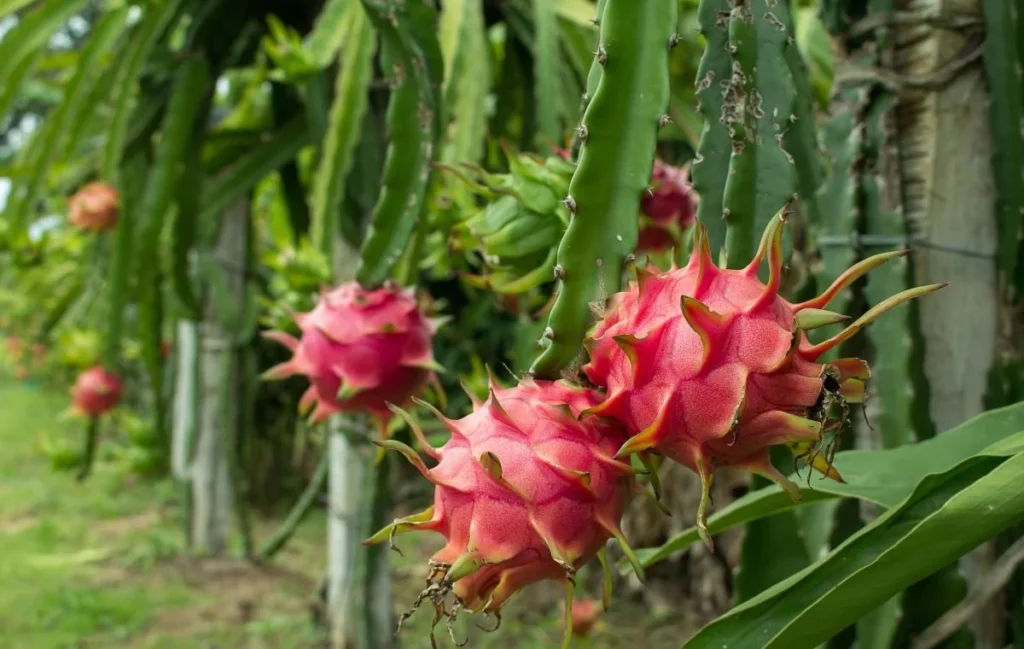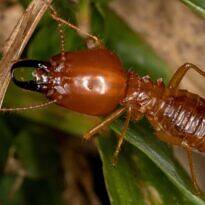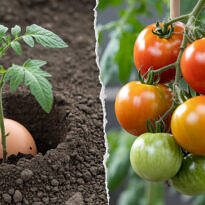If you’ve stumbled upon this article, chances are you’ve been captivated by dragon fruit and can’t wait to start planting them in your backyard, or perhaps even commercially, right?
A true gem of nature, the fruits of the pitaya are sweet, juicy, subtly flavored, and boast vibrant colors. They easily please the most refined palates.
It’s no wonder they captivate renowned chefs and inspire products like ice creams and other desserts that are a feast for the eyes and taste buds.
So if you’re also a dragon fruit aficionado, congratulations! You’ve come to the right place. Welcome to the world of pitaya, also known as dragon fruit, a true gem of modern horticulture. In this article, you’ll learn from the basics to advanced techniques on how to plant dragon fruit, with tips and secrets to ensure successful cultivation, whether you want to grow it in your backyard or include dragon fruit in your commercial orchards.
But what makes dragon fruit such a popular choice?

Native to Central and South America, but found in tropical and subtropical climates around the globe, pitaya or dragon fruit stands out with its stunning nocturnal flowers and brightly colored, intriguingly shaped fruits. In landscaping, this plant not only adds an exotic touch to gardens but also serves as a stunning focal point. And did you know that, beyond its breathtaking appearance, dragon fruit is a superfood?
Dragon fruit is low in calories but rich in vitamins C and B, minerals like calcium and iron, and antioxidants that help neutralize free radicals. The fiber content in pitaya promotes healthy digestion and may aid in blood sugar regulation. The seeds contain omega-3 and omega-9 fatty acids, beneficial fats that support heart health. With a low glycemic index, this fruit is an excellent option for those looking to maintain a balanced diet. Moreover, hydration is a bonus, as dragon fruit is composed mostly of water. Thus, its dietary and nutritional value makes it not just a stylish choice for embellishing dishes but also a powerful component for a healthy diet.
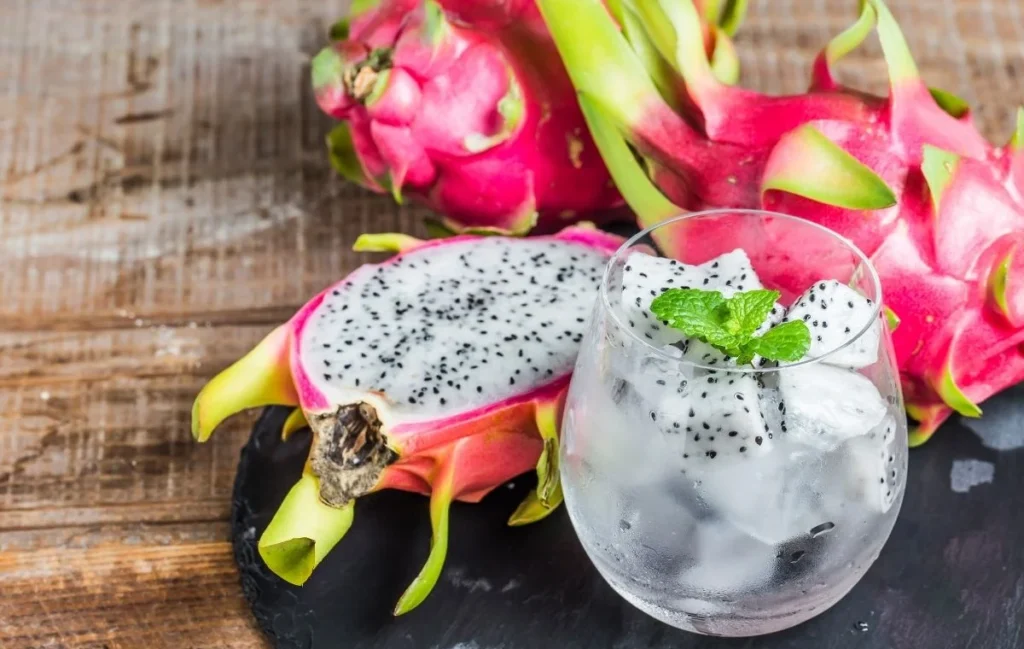
In other words, by choosing dragon fruit, we are transforming our gardens with not just beautiful, but also useful and sustainable landscaping, using edible plants and thereby bringing more exciting and needs-connected garden projects to life.
But how can you transform your garden with this tropical wonder?
In this article, we will dive into the techniques and secrets for successfully planting pitaya. We’ll cover everything from choosing the perfect soil to harvest practices that ensure tasty and juicy fruits. Stay tuned and discover:
What You Need to Know Before Planting the Dragon Fruit
Understanding the Dragon fruit
Before we get our hands dirty, it’s essential to understand the star of our cultivation.
Pitaya, also known as dragon fruit, is native to the Americas, including Mexico, Central, and South America. Thanks to explorers and traders, it is now cultivated and cherished in many tropical and subtropical regions worldwide. Its geographical distribution has expanded over the centuries, marking its presence in countries in Asia, such as Vietnam and Thailand, and even in the Middle East. Pitaya’s adaptability to different climates is a testament to its hardiness, but it truly thrives in conditions of high light, warmth, and moderate humidity.
Botanically speaking, dragon fruit belongs to the Cactaceae family and the genus Selenicereus, known for its long, climbing stems. These stems, often mistaken for “trunks,” are actually succulent stems that store water and nourish the plant. Noticeably, pitaya is leafless, like many cactus species, meaning the role of photosynthesis is performed by these climbing stems. Pitaya is characterized by its large, nocturnal flowers. They emit a charming fragrance to attract their natural pollinators, such as bats and moths.

The flowers are a spectacle in themselves, with petals ranging from white to pink, lasting only one night. After pollination, the plant develops its fruit: large, with a skin varying from yellow to intense pink, filled with flame-like protrusions, hence its popular name, dragon fruit. The inside of the fruit is a succulent and firm pulp, dotted with tiny black seeds, creating a visual contrast and an interesting texture for the palate.
Initially gathered by indigenous peoples, dragon fruit has been domesticated for centuries. The earliest evidence of its cultivation dates back to the Mayans and the indigenous peoples of Central America. Over time, its cultivation spread, and the fruit gained worldwide popularity for its ornamental beauty and sweet, mild flavor reminiscent of a mix between kiwi and pear.
Today, the dragon fruit is not just a luxury component in gourmet dishes but is also valued for its nutritional properties. Pitaya cultivation ranges from small family operations to large commercial plantations, highlighting its increasing demand and the importance of fully understanding how to cultivate it successfully.
Choosing the Type of Dragon Fruit
But before we proceed…
Have you thought about your favorite dragon fruit?
Before we venture into planting, it’s important to know the different dragon fruits and their characteristics. Some species may be more adaptable to your region than others, and this can make all the difference when cultivating. Moreover, the fruit’s color quality and flavor vary, and it’s pointless to plant a dragon fruit that doesn’t suit your taste. So let’s explore each of these species and their varieties:
White Dragon Fruit – Selenicereus undatus

Selenicereus undatus (formerly Hylocereus undatus) is the most common species, often heralded as the ‘white-fleshed dragon fruit.’ Its popularity stems not only from its moderate sweetness and mild flavor but also from its adaptability to a range of climatic conditions. This species is considered the hardiest and does well in both dry and humid climates, being somewhat resistant to climate variations.
Notable cultivars:
- ‘Alice’: Stands out for its large size and sweet flavor.
- ‘Cosmic Charlie’: A less common variety with vibrant skin color and exotic taste.
Red Dragon Fruit – Selenicereus costaricensis

Selenicereus costaricensis or S. polyrhizus (synonym), known as ‘red-fleshed dragon fruit,’ features a vibrant magenta-colored pulp. Less sweet than Selenicereus undatus, it offers a more earthy taste. It is a species that prefers warm, tropical climates and may not be as resistant to cooler temperatures.
Notable Cultivars:
- ‘Costa Rica Night’: Praised for its vigorous growth and large fruits.
- ‘Delight’: This cultivar is known for its consistent yield and well-balanced flavor.
Yellow Dragon Fruit – Selenicereus megalanthus

Finally, we have Selenicereus megalanthus, distinguished by its yellow skin and white flesh. With sweetness surpassing other species, this dragon fruit is also the most demanding, preferring growth conditions that mimic its natural habitat at higher altitudes in South America. Harvesting this species can be more laborious, as its spines require careful removal.
Notable Cultivars:
- ‘Yellow Dragon’: Known for its intense sweetness and high market value.
- ‘Ecuadorian Yellow’: Stands out for its robustness, yielding fruit under the right care.
When choosing among these different species, consider not just the climate and soil, but also the desired palate. If necessary, go to the market and purchase a fruit of each to taste. After all, each of these species has its particular cultivation requirements and characteristics that may influence the decision of which to grow.
Ideal Growing Conditions
Many beginners make the mistake of assuming that, as a cactus, pitaya prefers a desert’s arid climate. However, this is not the case. The dragon fruit is more accurately described as a hemiepiphytic plant originating from the humid regions of tropical forests. This means it prefers to grow supported by tree trunks, and while it values warmth, it also benefits from the humidity of this type of environment and should not be relegated to a desert setting.
Ideal Climate and Light Conditions
For those looking to cultivate dragon fruits, it’s essential to recognize its preference for a climate that combines heat with moderate humidity. Temperatures between 70-85°F (21-29°C) are ideal, but the plant is resilient enough to withstand fluctuations. Keep in mind that pitayas can endure temperatures down to 28°F (-2°C) or up to 104°F (40°C) for short periods. Plants suffering from the cold enter dormancy, just as those exposed to intense heat stop their photosynthesis to prevent dehydration. Avoid exposure to frost or severe cold, as they can cause burns and freezing damage to the plants.
Regarding light, dragon fruit needs an abundance of sunlight. Depending on the species and cultivar, your cultivation goal, and the climate of your region, it may be more beneficial to grow it in full sun or partial shade. Understand that most commercial plants adapt to both conditions. Nonetheless, at least 6 hours of filtered or direct sunlight per day are necessary for optimal development.
Let’s explore how the cultivation of the dragon fruit adapts to three distinct climate zones: subtropical, temperate, and tropical to equatorial.

Subtropical Climate
In subtropical climates, pitaya finds an ideal middle ground between the necessary warmth for its growth and the occurrence of cooler temperatures that are not extreme. In this setting, shading is generally not necessary, as the plant can tolerate and even benefit from direct sun exposure. Full sunlight drives photosynthesis and aids in the flowering and fruiting processes. However, monitoring humidity is crucial, as dry periods may require supplemental irrigation, while rainy periods demand excellent drainage to prevent root rot.
Temperate Climate
The challenge of cultivating dragon fruit in a temperate climate lies in the need to shield the plants from low temperatures. Greenhouses become an indispensable solution in this context. They provide a refuge from the cold and also allow for control of the growing environment, maintaining temperatures within an ideal range for dragon fruit, which generally prefers temperatures above 50°F (10°C). Furthermore, greenhouses can safeguard plants from frost damage, which can be detrimental and potentially lethal. The use of greenhouses should be carefully planned to prevent overheating and to ensure proper ventilation during warmer days.
Tropical to Equatorial Regions
In tropical to equatorial regions, the dragon fruit finds itself closer to its natural habitat, with plenty of warmth and high humidity. However, the intensity of solar radiation can be excessive here, leading to plant tissue burns and water stress. Therefore, while the plant tolerates direct sunlight, in some cases, partial shading may be beneficial, especially during peak sunlight hours. Keep in mind that in its natural habitat, it usually grows under the protection of the forest canopy. Hence, structures such as shade nets or intercropping with taller crops that provide natural shade can be effective strategies to mitigate excessive light and heat.
In each of these climates, the dragon fruit requires specialized management to ensure its growth and productivity. In subtropical climates, monitoring humidity is crucial; in temperate ones, protection against cold is vital; and in tropical to equatorial areas, controlling excessive sunlight becomes essential. Understanding these climatic nuances and applying them to the dragon fruit cultivation management is key to maximizing the potential of this lush plant.
Recommended Soil Type and pH
The ideal soil for pitaya mimics the substrate found in its natural, forest-like, and well-drained habitat. In some respects, they are akin to other cacti. That is, heavy and waterlogged soils are the enemies of their roots, so ensure good drainage, either through raised beds or by incorporating sand, gypsum, and organic matter into the soil. Never attempt to grow dragon fruits on waterlogged grounds without prior preparation.

Regarding pH, pitayas flourish in slightly acidic to neutral conditions, with the ideal soil pH ranging between 5.5 and 7. Before planting, conduct a pH test and adjust it if necessary. Soil correction can be done with sulfur to increase acidity or with lime to make it more alkaline, depending on what is needed. Adjusting the pH will allow for proper root development and adequate nutrient absorption from fertilizers to follow. In any case, always incorporate organic matter into the soil, which can come in the form of well-aged cattle manure. Remember, you are cultivating a fruit-bearing plant, and as such, it has a higher need for nutrients.
During land preparation, eliminate weeds and other plants that may compete with pitaya. Regardless of whether the soil requires raised beds, it is important to till the soil to a depth of 12 to 16 inches (30 to 40 cm) to ensure it is loose and aerated. Take this opportunity to incorporate additional organic matter, adjust the pH, and add phosphorus-rich planting fertilizers to promote rooting.
If planting dragon fruit in pots, which is perfectly feasible, use a good drainage layer at the bottom of the pot and a cactus-specific potting mix enriched with organic compost that provides excellent drainage.
How to Plant Dragon Fruit
Dragon Fruit are plants that are easily propagated, either by seeds or cuttings. They are also well-suited to grafting. If you have trouble growing a specific variety in your region, this method can be utilized. Thus, simply choose a variety that is well-adapted as the rootstock, and the desired variety as the scion. Grafting yields excellent results in dragon fruit, with high success rates, making it a choice cactus for use as a rootstock for a multitude of other cacti. However, grafting itself deserves its own article and will not be addressed in this one.
But after all, is it better to plant by seeds or cuttings?
If your goal in planting dragon fruit is for home and recreational purposes, and you have the patience to wait for results, growing from seeds can be very rewarding. Seed planting can also be a viable alternative if you don’t have access to high-quality cuttings or seedlings, or if your aim is to develop new plant varieties.
In practice, planting from cuttings should be your choice if you want to see your plants producing quickly, or if you wish to grow dragon fruit commercially, either for fruit production or for seedling propagation.
Shall we explore both methods of cultivation?
Growing Dragon Fruit from Seeds

Advantages:
- Genetic diversity: Each seed can result in a plant with unique characteristics, which can be beneficial for adaptation to different climatic conditions and disease resistance.
- Cost: If you already have fruit available, you can extract the seeds at no additional cost.
Disadvantages:
- Slow growth: Dragon fruit grown from seeds may take several years (5 to 7 years) to start fruiting.
- Inconsistency: Seeds bring genetic variability, which means there can be significant variation among plants in terms of fruit quality and quantity produced.
Step by Step Seed Planting:
- Extraction: Choose a ripe, tasty, and healthy fruit of the desired variety. Remove the dragon fruit seeds and wash them to remove the pulp. A tablespoon is enough to get a good amount of seeds.
- Drying: Spread the seeds and let them dry in the shade for 24-48 hours.
- Sowing: Plant the seeds in seedling trays with a light, well-drained potting mix, covering them with a thin layer of soil. You can increase germination rates by using a sterile potting mix.
- Environment: Water the seeds lightly with a sprayer every 5 days and keep the trays in indirect light until germination. Transparent vegetation boxes can be helpful to maintain constant humidity throughout the germination process. Protect the trays from direct sunlight to avoid excessive heat.
- Germination: After about 20 days, the seeds emit their first root and begin to develop.
- Transplanting: When the seedlings reach a few inches in height, transplant them into larger individual pots. Keep the pots proportional to the size of the plants and gradually move to larger pots as the plant grows.
- Staking: Remember that dragon fruits are climbers, so provide adequate support as soon as the seedlings begin to elongate.
- Permanent Planting: Once your seedlings reach about 12 inches (30 centimeters), they can be moved to their permanent location. Before proceeding with planting, acclimatize the plant to the site with gradually increasing light (an extra hour per week) to prevent burns.

Growing Dragon Fruit from Cuttings
Advantages:
- Rapid growth: Plants from cuttings usually grow faster and begin to bear fruit within 1 to 2 years.
- Uniformity: Cuttings are clones of the mother plant, resulting in fruit of predictable quality and characteristics.
Disadvantages:
- Need for Parent Plants: You must have access to healthy adult plants to provide cuttings.
- Lower Genetic Diversity: As they are clones, there is less genetic variability, which can be a concern in case of diseases.
Step by Step:
- Selection: Choose healthy branches from known productive and mature plants. Cuttings taken from plants younger than one year root with difficulty. Select branches from the lower or middle part of the plant. In temperate or subtropical climates, the best time for propagation by cuttings is in spring. However, if you have access to a greenhouse, you can also perform this operation in autumn. In tropical climates, cuttings of dragon fruit can be done all year round, but preferably after fruiting.
- Cutting: Use a pruning shear, and cut cuttings 8 to 12 inches (20 to 30 cm) in length, choosing preferably the internodes. The stems have thorns, so protect yourself with thick gloves. Mark the position of the cutting on the plant, with a pen or tape, so it’s easy to identify the end closest to the roots, to avoid planting upside down later.
- Curing: Let the cuttings cure for about a week in a dry, shaded place to form a callus on the cut end. Planting immediately leads to a greater loss of cuttings, which become susceptible to fungal infections and rot.
- Planting: Plant the cuttings in containers with a cactus-specific potting mix, preferably enriched with organic matter. For rapid rooting, use a rooting hormone (such as Indole-3-butyric acid), or products designed for rooting, with seaweed extracts, like Forth Root or Seacrop. Bury the cutting about 2 inches (5 cm) into the soil.
- Stabilization: Use a support stake if necessary to keep the cutting upright while it establishes itself.
- Location: Keep the planted cuttings in a place with abundant light, but protected from direct sunlight. They do not yet have roots and can dehydrate quickly under full sun conditions.
- Watering: Keep the soil slightly moist, but never waterlogged, until the plant begins to sprout, indicating that the cutting has already developed strong roots.

Planting in the Final Location
After the seedlings are well-formed, we must proceed with acclimatization. As they grew under protected conditions in their initial stages, they lost their ability to tolerate direct sunlight exposure. Otherwise, they may suffer from burns and oxidative stress. Therefore, before planting in the final location, it is advisable to gradually shift from partial shade to full sun over a few weeks. Start by exposing the seedlings to morning sun and increase by one hour per week until they are receiving 6 hours of direct sunlight per day. During this phase, the use of amino acid-based fertilizers helps the plants to cope with the stressful period so that their development is not compromised.
- Preparation: The soil should be prepared preferably 3 months in advance. It should be tilled and pH adjusted – remember that dragon fruit prefers slightly acidic soil, with a pH between 5.5 to 7. Add organic matter and a high-phosphorus fertilizer suitable for planting.
- Planting Bed: Prepare the planting bed by digging holes about 8 to 12 inches (20 to 30 cm) deep and wide. However, take into account the size of the seedling containers. The planting bed should be slightly larger.
- Planting: Remove the pot or planting bag carefully so as not to damage the plant’s roots. If the seedling has been waiting for planting for a long time, with tangled roots, it is important to prune the roots to encourage normal growth.
- Mulching: Cover the base of the seedling with a thin layer of soil, and add mulch around the plant. You can use pine bark or even agricultural fabric. It is important that this mulch does not touch the stem of the plant.
- Watering: Water immediately and whenever you notice the soil is very dry. If you choose a rainy period to plant, you won’t need to worry about watering.
- Spacing: Depending on the cultivation method and the supports you chose, the spacing may vary. Take as a principle a spacing of about 10 feet (3 meters) between plants, and 6.5 feet (2 meters) between rows. Besides reducing competition, this spacing will facilitate management, such as harvesting.

Support and Training of Dragon Fruit
One of the most important aspects to consider at the time of planting is support. Dragon fruit is a climbing cactus and, as such, requires a support to attach itself to and grow properly. Without support, it grows disoriented on the ground, like a creeping plant. In the garden, we can plant it near a tree that it can climb, or prepare a support, like a post, for it. In commercial cultivation, you should seriously consider the choice of support, as this may interfere with future management and even the integrity of your dragon fruit orchard.
You read that right…
Neglecting the training can jeopardize the integrity of your production.

It turns out that many growers adapt trellis, tendones, and espalier techniques, which are used for other climbing fruit plants such as grapes, kiwis, or passion fruit. However, what few consider is that dragon fruit plants often weigh much more than these plants. In addition to the succulent vegetation itself, when in full fruiting, there are hundreds of pounds (kilos) on the support structures. Therefore, you need to think about a support that is both robust, strong, and gentle with these plants.
The posts, whether individualized for each plant or used to support the structure, should preferably be made of reinforced concrete or high-quality wood. If you use wires to support the plants, choose double and steel ones and consider that you will need to protect them with hoses or tires, since wires and rebar can injure the succulent stems of dragon fruit.

Dragon fruit attaches to its supports through aerial roots, and they do not adhere to metal surfaces, preferring the porosity of wood or concrete. Thus, you should offer supports in these materials, or use twine to guide them to the horizontal trellis, so they can then lean and spill their branches. Do not think that you can replace the support with a better one over time. Ideally, the plants should already receive their definitive supports at this stage. The attempt to remove or change the support will cause injuries to plants that are already well adhered.
Knowing these details, you can think about how to make a modified trellis, tendone, or espalier, reinforced and suitable for dragon fruit plants. An interesting alternative is the use of walls, since dragon fruit can crown them majestically. Vegetable growers, who use walls to protect their crops from strong winds, have taken advantage of these places to plant dragon fruit, with success.
When tutoring your dragon fruit, consider that you should use two plants per post, where they will grow only one or two vertical branches per plant. The horizontal structures, where the plants can branch out and spill their branches, should be raised between 4.9 to 5.9 feet (1.5 to 1.8 meters) in height, facilitating management. During the growth in height, do not trust that the dragon fruit will find the support and fix itself alone, help them by tying them with twine to the supports.
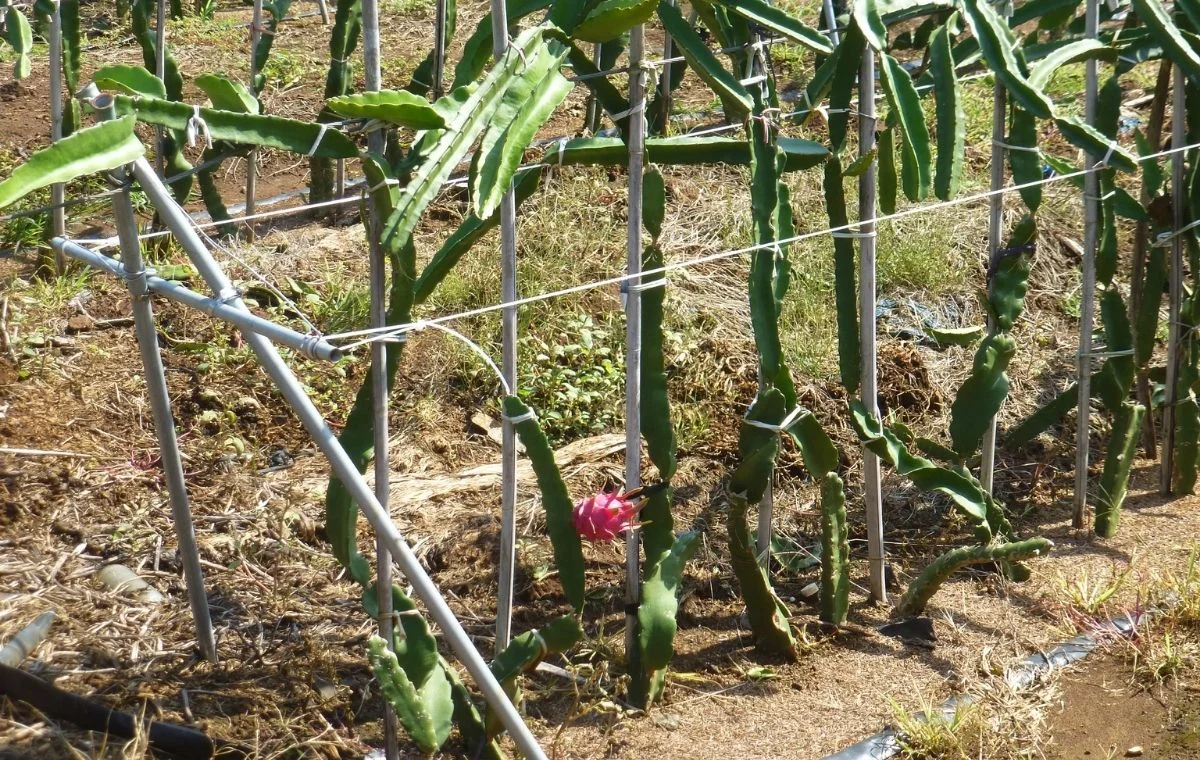
Post-Planting Care
After making the dream of cultivating dragon fruit a reality, it is time to enter the critical phase that dictates the success of your cultivation: post-planting care. This stage is crucial and requires special attention to irrigation and nutrition, as well as to pruning and support techniques.
Irrigation and Nutrition
Dragon fruit, despite being a resistant cactus, has its specific demands when it comes to water and nutrients. Remember that unlike most other cacti, dragon fruit grows quickly and is quite fruitful, so it has greater demands.
Irrigation frequency and amount:
- Establishing plants: After planting, irrigation should be more frequent to ensure the plants’ establishment. Water every 2-3 days, allowing the soil to dry out slightly between waterings.
- Established plants: Once the plants are established, the frequency can be reduced. Dragon fruit tolerates drought, but regular watering promotes growth and fruiting. During the vegetative period, water weekly.
- Fruiting: The formation of succulent fruits requires a larger amount of water, but do not overdo it. Excessive irrigation during this period will cause the fruits to crack.
- Soil monitoring: Use a moisture meter or check the soil up to about 6 inches (15 cm) deep. If it’s dry, it’s time to water.
Fertilization Recommendations and Essential Nutrients:
- Initial Fertilization: After planting, use a phosphorus-rich fertilizer to encourage root development.
- Maintenance: During growth, apply a balanced fertilizer (like NPK 10-10-10) bi-monthly.
- Fertilization during fruiting: Increase potassium to enhance the quality of the fruits.
- Foliar Nutrition: Foliar sprays with microelements (such as boron and zinc) can correct specific deficiencies and improve overall plant health.
How to Prune Dragon Fruit
Pruning is a vital component in dragon fruit cultivation, essential for both healthy plant development and quality fruit production. There are three main types of pruning: formative, maintenance, and rejuvenative. Each has a specific purpose and an ideal timing.
Formative Pruning
This is the initial pruning and is crucial for establishing the plant’s structure.
- When: Carry it out in the first and second year after planting, when the plant reaches about 12 inches (30 cm) in height.
- Objective: To direct vertical growth and encourage the development of a strong main stem.
- Procedure: Select 2 to 4 main branches and prune the rest. These selected branches should be attached to the support and will provide a structure for the plant to grow in a balanced and robust manner.

Maintenance Pruning
This pruning is carried out regularly to keep the plant healthy and productive.
- When: Annually, after the end of the harvest, usually in late fall or early winter.
- Objective: To remove excessive, damaged, or fruiting branches to improve aeration and light exposure. The center of the plant should be visible from all angles after pruning.
- Procedure: Identify branches that have fruited, as they rarely produce again. Prune these at the base. Also remove any dry, damaged, or diseased branches to prevent them from becoming vectors for disease.
Rejuvenative Pruning
This is a more intensive pruning aimed at renewing older plants.
- When: Every 3-4 years, depending on the plant’s vitality and production.
- Objective: To revitalize old plants and stimulate the growth of new productive branches.
- Procedure: Make more drastic cuts, reducing the plant by about a third or half of its size. Remove inner branches to encourage the growth of new fruit-bearing branches and improve ventilation and sunlight penetration.
In all types of pruning, it is critical to use properly sterilized tools to prevent the transmission of diseases. Clean and precise cuts also aid in the plant’s quick recovery. For young and tender branches, pruning shears will suffice. For older branches, a saw may be necessary. After pruning, it is advisable to apply a natural fungicide, such as a copper-based paste, to protect the cuts from potential fungal infections to which cacti are very susceptible.
Pruning is not just a matter of aesthetics or convenience; it is an agronomic practice that stimulates plant vigor and fruit production. By adopting a careful and methodical approach to pruning your dragon fruit, you are investing in the future of your production and the overall health of your plants.
Pollination of Dragon Fruit
Dragon fruit significantly depends on the pollination process for successful fruiting. Numerous, large, and heavy fruits are only achieved through effective pollination. In its natural habitat, pollination is predominantly a nocturnal spectacle. The dragon fruit flower, also known as the “queen of the night,” blooms at dusk and during the night, attracting specific nocturnal pollinators such as bats and, in some regions, large moths. These pollinators are lured by the intense aroma and nectar the flowers offer, and in their quest for sustenance, they inadvertently transfer pollen from one flower to another, promoting cross-pollination.
Varieties and Pollination Needs

It’s crucial to understand that there are variations among dragon fruit species that affect their pollination needs. Some varieties are self-pollinating, meaning they can fertilize themselves with their own pollen, while others require cross-pollination to produce fruit. Self-pollinating dragon fruit typically have a higher fruiting rate under isolated conditions, which is advantageous for growers who do not have a wide variety of plants. On the other hand, varieties that require cross-pollination depend on the presence of another dragon fruit of a different genetic lineage for pollen transfer to occur and fertilization to be successful.
Manual Pollination: A Step-by-Step Guide
In commercial cultivation or gardens where natural pollinators are not present in sufficient numbers, manual pollination becomes a valuable tool to ensure fruit production. Here’s how to perform this process:
- Identification of the Bloom: The first step is to identify the flowers that are ready to be pollinated. This is done by observing the dragon fruit flowers that open at night and remain open until the early hours of the morning.
- Pollen Collection: Using a soft brush or cotton swab, carefully collect the pollen from the anthers of a flower. If you are working with varieties that require cross-pollination, make sure to collect pollen from a genetically distinct plant.
- Pollen Transfer: Gently transfer the collected pollen to the stigma of the same flower or another flower, depending on the need for self-pollination or cross-pollination. The stigma is the sticky upper part of the pistil, located in the center of the flower.
- Repeat the Process: Repeat the procedure on several flowers to increase the chances of successful fertilization.
- Records and Observations: It is advisable to keep a record of manually pollinated flowers to monitor the success rate and adjust techniques as necessary.
Manual pollination is a precise technique that requires delicacy and attention to detail, but when done correctly, can significantly increase the productivity of dragon fruit. Pollination can be cross with compatible varieties or with self-pollination, depending on the variety. This phase is critical, as it will determine the quality and quantity of the harvest. The dragon fruit flower is ephemeral, opening only once at night and closing in the morning, and pollination must occur in this brief interval.
Cultivation Secret: When the flower opens and is consequently fertilized (shortly after the flower opens), we can put a different colored tape each day. From this, we can count 4 weeks (or another period according to the cultivar – it is important to observe and conduct tests) for that fruit, to be harvested.
When Should Dragon Fruit Be Harvested?

Dragon fruit reaches maturity between 30 to 50 days after flowering. Unlike other fruits such as papayas or bananas, dragon fruit does not ripen after being picked, so it must be harvested at the right point of maturation. Indicators that the fruit is ready for harvest include:
- Color Change: The fruit’s skin changes from a vibrant green to a deep pink or yellow, depending on the variety. Wait for the base and tip of the fruit to be colored before harvesting. The tips of the fruit’s bracteoles may wilt slightly.
- Texture: The mature dragon fruit tends to give slightly to the touch, without being overly soft.
- Aroma: A sweet and subtle fragrance is often emitted by the ripe fruit.
- Fruit Suture: If it begins to split slightly at the suture, it is a sign that the dragon fruit is at the optimal point of maturation.
Harvesting Techniques to Preserve Fruit Quality:
- Use pruning shears or a sharp, sterilized knife to cut the stem about 0.2 to 0.4 inches (0.5 to 1 cm) from the fruit.
- Avoid pulling the fruit, as this can damage the mother plant and the dragon fruit itself.
- Harvest during the cooler hours of the day to minimize stress on the fruit.
- Handle with care to avoid bruising the skin, which can lead to premature deterioration.
Tips for Storage and Extending Freshness:
- Chill the fruits after harvesting to reduce respiration and prolong their shelf life.
- Keep dragon fruits at a temperature of 45 to 50°F (7 to 10°C) with a relative humidity of 90-95% to maximize shelf life.
- Avoid storing with ethylene-emitting fruits such as apples and bananas, as this can accelerate the wilting process.

Considerations for the Marketing of Dragon Fruit:
- Package the fruits in materials that minimize mechanical damage and protect against shocks during transport.
- Use packaging that promotes ventilation and prevents the accumulation of moisture.
- Be discerning with the external appearance of the dragon fruit for sale, as it is the first selection criterion for consumers.
- Build a brand narrative that highlights the nutritional qualities, the sustainable cultivation mode, and the origin of the dragon fruits.
- Explore marketing channels that value exotic and niche products, such as gourmet stores, organic product fairs, and e-commerce platforms.
By following these tips, one can maximize the quality and market value of the dragon fruit, ensuring that the fruit not only delights the palate but also contributes to the economic viability of its cultivation.
Pests and Diseases of Dragon fruit
Pitaya, or dragon fruit, is a relatively hardy crop, yet still susceptible to certain pests and diseases. Prevention and proper management are crucial to ensure healthy growth and abundant fruit production. Let’s look at the most common pests and diseases:
- Mealybugs: These sap-sucking insects are often found on pitayas, causing the stems to yellow. For control, neem oil or insecticidal soap can be effective. In severe cases, specific insecticides, as per agronomic recommendations, may be necessary.
- Mites: Mites can attack the stems, causing spots and eventually leading to premature dropping of the stems. Control can be achieved with acaricides and by increasing the relative humidity, as mites do not thrive in moist environments.
- Cactus Moth: This pest bores into the stem of pitaya, compromising the entire plant. Control is carried out through the removal and destruction of infested parts and the application of registered insecticides for this purpose.
- Birds, rodents, and other animals: Be aware of bird pecks and rodent attacks that can feed on both the fruits and the stems.
- Root Rot: Caused by fungi like Phytophthora, root rot can be prevented through good soil drainage and avoiding excessive moisture. Fungicidal treatments can be applied in cases of established infection.
- Anthracnose: This fungal disease manifests as dark spots on fruits and stems. Prevention involves removing affected fruits and stems and applying appropriate fungicides. It is also important to avoid injuries to the plants, through which the fungus usually enters.
- Bacterial Spot: Bacteria can cause watery spots on stems and fruits, evolving into necrotic areas. The best form of prevention is the use of proper cultural practices, such as crop rotation and irrigation control. Treatments include specific bactericides and hygiene practices to prevent spread.

Integrated Pest and Disease Management
Effective control of pests and diseases in dragon fruits involves a combination of preventative practices, constant monitoring, and timely interventions when necessary. It is crucial that measures taken are based on technical knowledge and consider the overall health of the plant, the environment, and food safety. Therefore, we recommend:
- Regular monitoring of plants for early detection of problems.
- Use of cultural practices that promote plant health and prevent the establishment of pests and diseases.
- Implementation of biological control, using natural predators when possible.
- Application of chemical treatments only as a last resort and following technical recommendations to minimize environmental impacts and human health risks.
Dragon Fruit in Landscaping: An Exotic and Functional Touch
Pitaya stands out in landscaping for its sculptural aesthetics, colorful fruits, and spectacular night blooms, offering a combination of beauty and functionality. When integrated into structures like trellises and pergolas, or crowning walls, its succulent stems create attractive visual patterns, turning into true living sculptures that enhance any space. Additionally, these structures assist in providing adequate ventilation and sunlight exposure, essential for the productive cultivation of the plant.

In urban environments, where space is a luxury, the dragon fruits grown in pots become central pieces on balconies, patios, and terraces, bringing a tropical touch and versatility to the design. Such pots can be moved to optimize cultivation conditions or to reorganize spaces, meeting both aesthetic and practical needs.
Incorporating dragon fruit into garden design is not just a stylistic choice but a smart strategy for creating dynamic and functional environments. Whether forming an alley along paths or serving as a green screen to hide unwanted elements, pitaya is a valuable addition that brings color, life, and texture to contemporary landscaping.
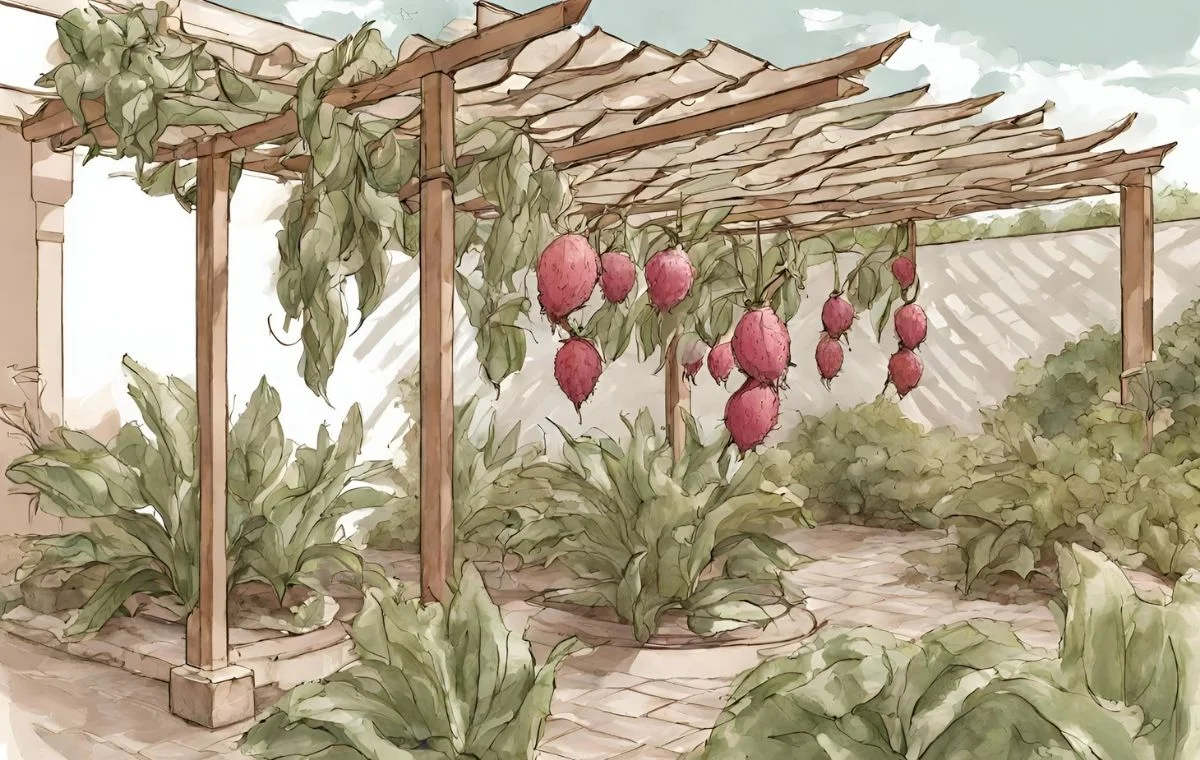
As we conclude our detailed journey on how to plant pitaya, we reflect on the essential steps we’ve covered. From careful site selection, meticulous soil preparation, choosing the best varieties, and planting techniques, to pest and disease management, each stage is a critical link in the chain leading to success in cultivating this exotic and tasty fruit.
Although the dragon fruit may seem intimidating to some growers, we’ve seen that, with the right strategies and dedicated attention, it is possible not only to grow it but to make it thrive, whether as a stunning element in landscaping or as an addition to your home or commercial orchard.
I hope you apply the knowledge gained here and experiment with your own dragon fruit plantings. Remember that nature is a living laboratory, and each plant you cultivate contributes to your experience and expertise.
And don’t let your gardening journey end here. There’s always more to learn, more to grow, and more experiences to share. We invite you to read our other articles and browse through the website. Together, let’s continue cultivating not just pitayas, but a community of gardening enthusiasts who support, learn, and grow together.

